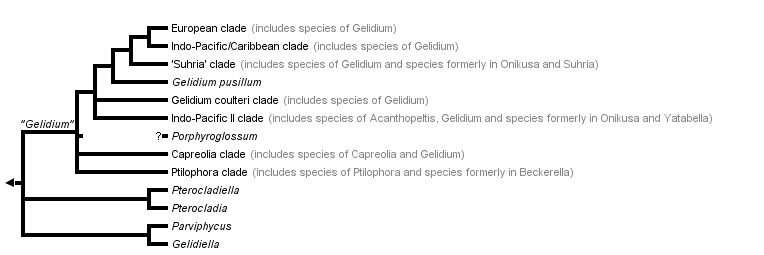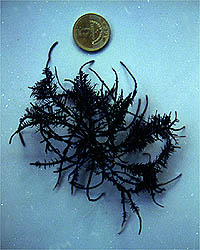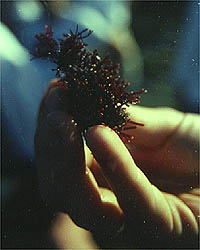Gelidiales
D. Wilson Freshwater


This tree diagram shows the relationships between several groups of organisms.
The root of the current tree connects the organisms featured in this tree to their containing group and the rest of the Tree of Life. The basal branching point in the tree represents the ancestor of the other groups in the tree. This ancestor diversified over time into several descendent subgroups, which are represented as internal nodes and terminal taxa to the right.

You can click on the root to travel down the Tree of Life all the way to the root of all Life, and you can click on the names of descendent subgroups to travel up the Tree of Life all the way to individual species.
For more information on ToL tree formatting, please see Interpreting the Tree or Classification. To learn more about phylogenetic trees, please visit our Phylogenetic Biology pages.
close boxTree based on Freshwater et al. 1995, Freshwater and Bailey 1998, Shimada et al. 1999, Rico et al. 2002, and Freshwater unpublished. Clade labels refer to the type of morphology and development of the female reproductive system and carposporophyte as discussed in Bailey and Freshwater (1997).
Introduction
The Gelidiales is a relatively small order of red algae containing ca. 130-140 species placed in ten recognized genera. Many gelidialean species are economically important as sources of high quality agars. The order is defined by the unique set of characters listed below.
Characteristics
Species within the Gelidiales share a unique set of characters that make this a well-defined order of red algae. These characters include:
- a triphasic life history with isomorphic gameto- and tetrasporophytes
- agar as a cell wall component
- pit plugs with a single cap layer
- a special "Gelidium-type" spore germination pattern
- uniaxial filaments that branch in three planes forming a pseudoparenchyma
- intercalary carpogonia that after fertilization produce gonimoblasts that connect to nutritive cells
- transversely divided spermatangia
Discussion of Phylogenetic Relationships
Four major lineages have been identified by molecular analyses of taxa within the Gelidiales (Bailey and Freshwater 1997, Freshwater et al. 1995, Freshwater and Bailey 1998, Shimada et al. 1999). The morphology and development of the female reproductive system and carposporophyte may also define these lineages (Bailey and Freshwater 1997, Hommersand and Fredericq 1988, 1996, Santelices and Hommersand 1997). Three of the lineages are equivalent to the monophyletic genera Pterocladiella, Pterocladia, and Gelidiella. The fourth lineage defines a large clade that includes species of Acanthopeltis, Capreolia, Gelidium, Porphyroglossum, and Ptilophora. As noted on the Gelidiales tree above, species representing four other genera are also resolved within this lineage, but recent studies have synonimized these with currently recognized genera (Norris 1987, Shimada et al. 1999, Tronchin et al. 2003a). Analyses of nuclear-encoded 28S rRNA gene sequence data (Freshwater and Bailey 1998) and a combined four gene data set (Freshwater unpublished) have resolved Pterocladia and Pterocladiella as sister taxa, but relationships among the four major lineages can not currently be determined based upon non-molecular characters. The morphology and development of the Gelidiella female reproductive system and carposporophyte is unknown, and therefore the associated characters, which define the other three lineages, cannot be used to determine phylogenetic relationships among them.
Most species included in molecular analyses have been resolved within the "Gelidium" lineage. As noted above, this lineage includes species of not only Gelidium, but four other currently recognized genera as well. Molecular analyses identify at least eight clades within this lineage that have been referred to as "species complexes" or "species clades" (Freshwater and Rueness 1994, Freshwater et al. 1995, Shimada et al. 1999, Tronchin et al. 2003a). In contrast to the four major gelidialean lineages, morphological and/or developmental synapomorphies are unverified for all but the Ptilophora clade. The vegetative thalli of all species in the Ptilophora clade are constructed of four tissue layers composed of different cell types (Tronchin et al. 2003b). Santelices (1999) has defined a number of characters associated with the development of the cystocarp that may be synapomorphies for species clades within the "Gelidium" lineage. Further study is needed to determine if these or other characters will be useful for phylogenetic analyses.
References
Bailey, J.C. and D.W. Freshwater. 1997. Molecular systematics of the Gelidiales: Inferences from separate and combined analyses of plastid rbcL and nuclear SSU gene sequences. Eur. J. Phycol. 32:343-352.
Fan, K.-C. 1961. Morphological studies of the Gelidiales. University of California Publications in Botany 32:315-368.
Freshwater, D.W. and J. Rueness. 1994. Phylogenetic relationships of some European Gelidium (Gelidiales, Rhodophyta) species based on rbcL nucleotide sequence analysis. Phycologia 33:187-194.
Freshwater, D.W. and J.C. Bailey. 1998. A multigene phylogeny of the Gelidiales including nuclear large-subunit rRNA sequence data. J. Appl. Phycol. 10:229-236.
Freshwater, D.W., S. Fredericq and M.H. Hommersand. 1995. A molecular phylogeny of the Gelidiales (Rhodophyta) based on analysis of plastid rbcL nucleotide sequences. J. Phycol. 31:616-632.
Hommersand, M.H. and S. Fredericq. 1988. An investigation of cystocarp development in Gelidium pteridifolium with a revised description of the Gelidiales (Rhodophyta). Phycologia 27:254-272.
Hommersand, M.H. and S. Fredericq. 1996. Vegetative and reproductive development of Pterocladia capillacea (Gelidiales, Rhodophyta) from La Jolla, California. Nova Hedwigia 112:147-160.
Norris, R.E. 1987. A re-evaluation of Ptilophora Kutzing and Beckerella Kylin (Gelidiales, Rhodophyceae) with a review of South African species. Botanica Marina 30:243-258.
Rico, J.M., D.W. Freshwater, K.G. Norwood and M.D. Guiry. 2002. Morphology and systematics of Gelidiella tenuissima (Gelidiales, Rhodophyta) from Gran Canaria (Canary Islands, Spain). Phycologia 41, 463-469.
Santelices, B. 1988. Synopsis fo biological data on the seaweed genera Gelidium and Pterocladia (Rhodophyta). FAO Fisheries Synopsis 145, 55 pp.
Santelices, B. 1999. Patterns of carposporangial production among species of Gelidium (Gelidiales, Rhodophyta). Pages 55-69 in Taxonomy of economic seaweeds with reference to some Pacific species, Volume VII (I.A. Abbott, ed.). California Sea Grant College System, La Jolla, California.
Santelices, B. and M.H. Hommersand. 1997. Pterocladiella, a new genus in the Gelidiaceae (Gelidiales, Rhodophyta). Phycologia 36:114-119.
Shimada, S., T. Horiguchi and M. Masuda. 1999. Phylogenetic affinities of genera Acanthopeltis and Yatabella (Gelidiales, Rhodophyta) inferred from molecular analyses. Phycologia 38:528-540.
Tronchin, E.M., D.W. Freshwater, J.J. Bolton and R.J. Anderson. 2003a. A reassessment and reclassification of species in the genera Onikusa Adatsuka and Suhria J. Agardh ex Endlicher (Gelidiales, Rhodophyta) based on molecular and morphological data. Botanica Marina (in press).
Tronchin, E.M., D.W. Freshwater and J.J. Bolton. 2003b. A re-evaluation of species in the genera Beckerella and Ptilophora (Gelidiales, Rhodophyta) based on molecular and morphological data. Phycologia (in press).
Title Illustrations

| Scientific Name | Gelidiella acerosa |
|---|---|
| Location | collected at Cahuita on the Caribbean coast of Costa Rica |
| Comments | 5 Colones coin = 2 cm |
| Image Use |
 This media file is licensed under the Creative Commons Attribution-NonCommercial License - Version 3.0. This media file is licensed under the Creative Commons Attribution-NonCommercial License - Version 3.0.
|
| Copyright |
© 2002

|
| Scientific Name | Gelidium arbuscula |
|---|---|
| Location | collected on the north coast of Gran Canaria, Canary Islands |
| Acknowledgements | Hand model courtesy of Jose Rico |
| Image Use |
 This media file is licensed under the Creative Commons Attribution-NonCommercial License - Version 3.0. This media file is licensed under the Creative Commons Attribution-NonCommercial License - Version 3.0.
|
| Copyright |
© 2002

|
About This Page
Support for this page was provided in part by the National Science Foundation.

University of North Carolina, Wilmington, North Carolina, USA
Correspondence regarding this page should be directed to D. Wilson Freshwater at
Page copyright © 2002
 Page: Tree of Life
Gelidiales.
Authored by
D. Wilson Freshwater.
The TEXT of this page is licensed under the
Creative Commons Attribution License - Version 3.0. Note that images and other media
featured on this page are each governed by their own license, and they may or may not be available
for reuse. Click on an image or a media link to access the media data window, which provides the
relevant licensing information. For the general terms and conditions of ToL material reuse and
redistribution, please see the Tree of Life Copyright
Policies.
Page: Tree of Life
Gelidiales.
Authored by
D. Wilson Freshwater.
The TEXT of this page is licensed under the
Creative Commons Attribution License - Version 3.0. Note that images and other media
featured on this page are each governed by their own license, and they may or may not be available
for reuse. Click on an image or a media link to access the media data window, which provides the
relevant licensing information. For the general terms and conditions of ToL material reuse and
redistribution, please see the Tree of Life Copyright
Policies.
- First online 21 May 2002
Citing this page:
Freshwater, D. Wilson. 2002. Gelidiales. Version 21 May 2002. http://tolweb.org/Gelidiales/21751/2002.05.21 in The Tree of Life Web Project, http://tolweb.org/










 Go to quick links
Go to quick search
Go to navigation for this section of the ToL site
Go to detailed links for the ToL site
Go to quick links
Go to quick search
Go to navigation for this section of the ToL site
Go to detailed links for the ToL site